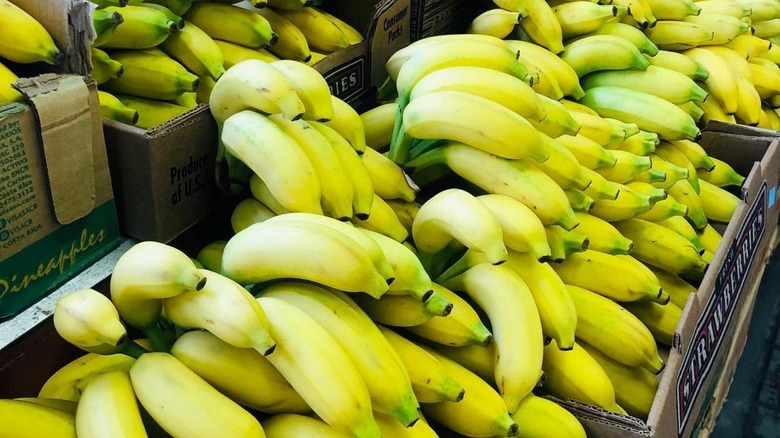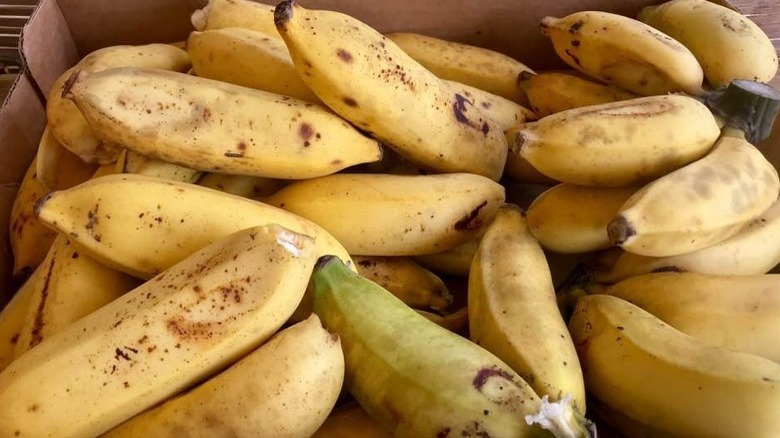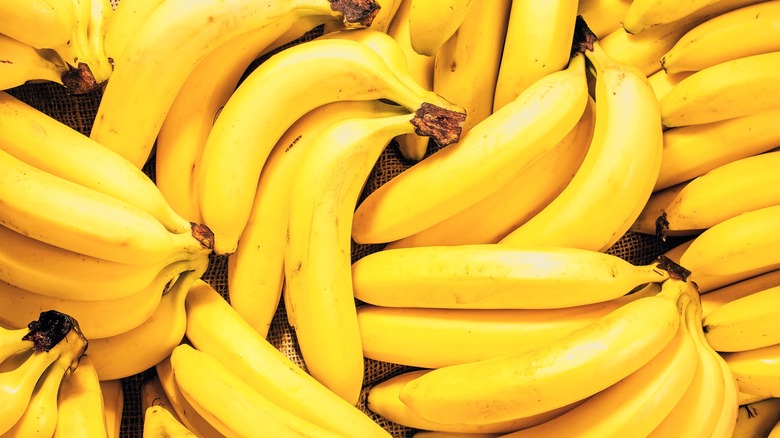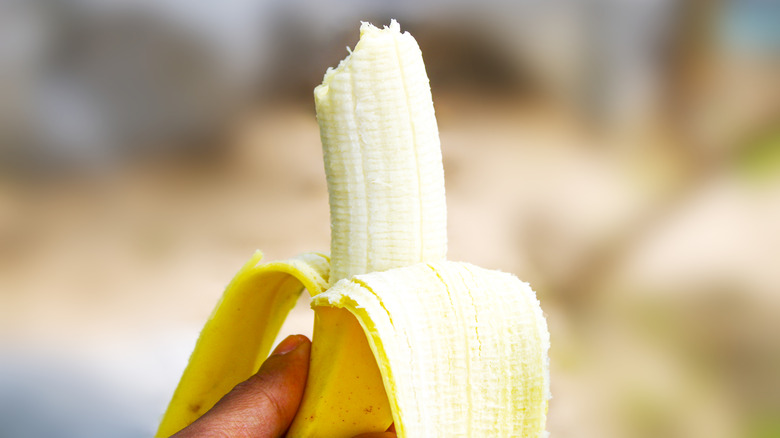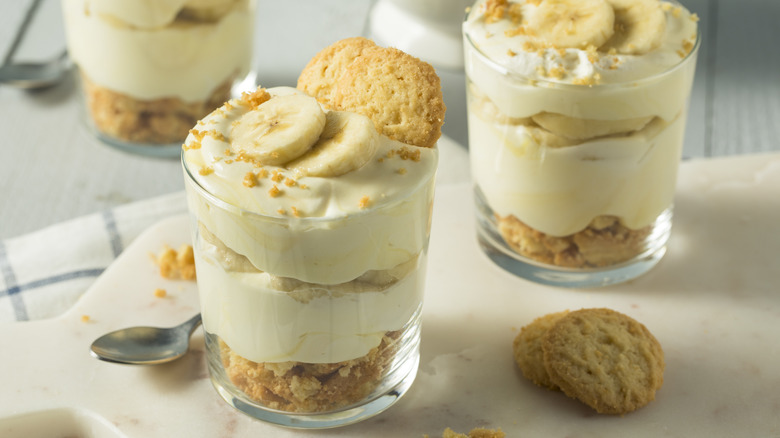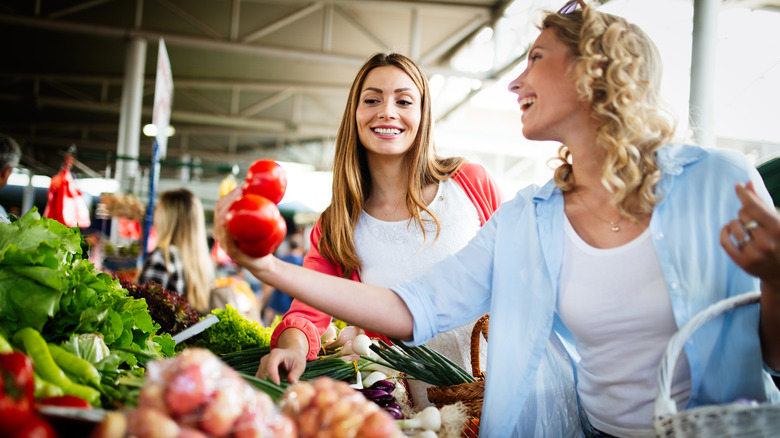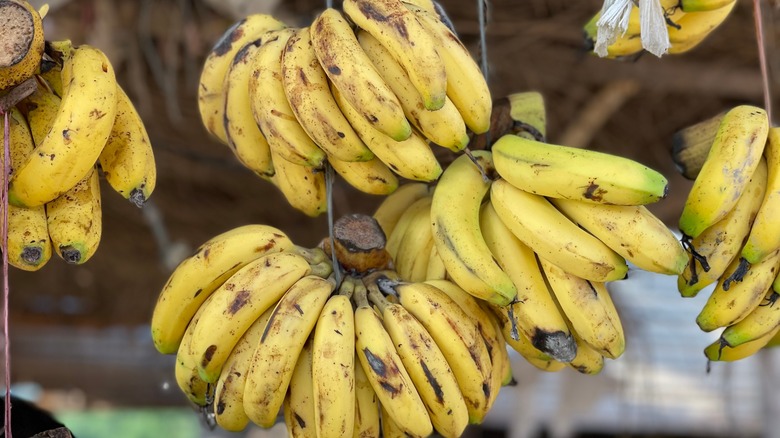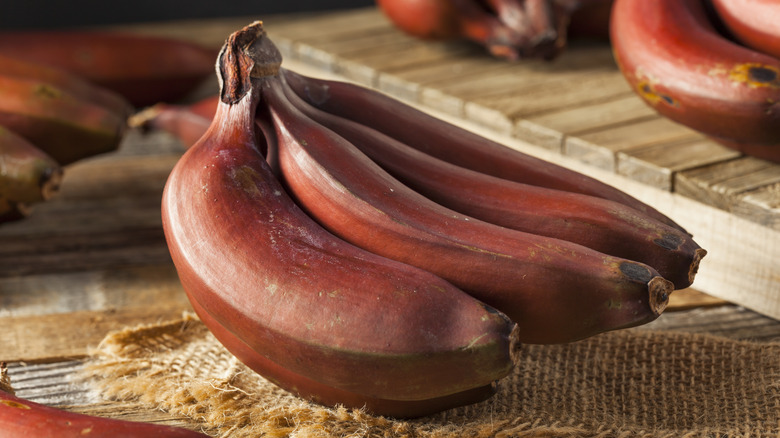What Are Apple Bananas And What Do They Taste Like?
What do you get when you combine an apple and a banana? While apple bananas do exist, they're not a direct 50-50 mashup of the two popular fruits — and in fact, these bananas don't have any apples in them at all. This variety of the yellow fruit got its name because of its apple-like flavor, which is sweeter and tangier than most other types of bananas. In fact, apple bananas are actually a general term used for a variety of smaller bananas like Silk, Manzano, and Tundans.
Compared to Cavendish, the most popular type of the fruit that we typically eat in the U.S., apple bananas are extra sweet with a firmer texture and shades of pink in their flesh. In fact, they're so sweet that they're also called Hawaiian candy apple bananas. So if you're curious about the different types of bananas beyond what we typically see in American grocery stores, you may enjoy sampling this short, sugary variety.
What are apple bananas?
The scientific name for apple bananas is Musa balbisiana x acuminata — which is quite a mouthful, so it may be easier to think of them as part of the Musaceae family. The fruits are relatives of all the other types of bananas, of course, as well as plantains, arrowroot starch, ginger, and the birds of paradise flower. Although apple bananas may be somewhat of a novelty in the U.S., they may go back as far as 3,000 years and are thought to have originated in the Philippines. They still grow there today, as well as in other areas of Southeast Asia, South America, and Hawaii. The apple variety may not be as common in the United States as in other parts of the world due to the less-than-ideal conditions for growing bananas, but they may still be imported occasionally.
Apple bananas are typically about 5 inches long, and compared to a typical Cavendish banana, which is approximately 8 inches long, this creates quite a notable size difference. They're also typically straight or slightly curved. On the outside, they are similar in color to other types of bananas since they're bright yellow and get browner as they ripen; but on the inside, their fruit has a slightly rosy shade, more reminiscent of an apple.
Apple bananas vs. Cavendish bananas
Most of the time, if we're going to a grocery store in the U.S., we're picking up a Cavendish banana. Also called dessert bananas, these are the most popular variety in nontropical countries, while apple bananas are much more popular in Asia and South America. Compared to the candy-like sweetness of apple bananas, the Cavendish variety has a mildly sugary flavor and is creamy in texture. At peak ripeness, the latter fruits have yellow flesh that turns brown and eventually black. Apple bananas, however, are a little whiter and pinker on the inside, with firmer flesh. When they turn brown, it means that they are getting sweeter, not that they are going bad. The skin on the Cavendish variety is also thick and yellow, while the apple banana is thinner and more delicate.
Both bananas are nutritious and contain potassium, as well as vitamins A and C. The Cavendish type is made by cloning, and will therefore always taste the same no matter when and where you eat one. Apple bananas, however, are not commercially mass-produced the same way their Cavendish counterparts are, as they are more often grown on farms or in gardens.
What do apple bananas taste like?
Apple bananas are much sweeter than what we're used to eating in the States. Their fruity flesh has notes of apple, strawberry, and pineapple, along with a slight tang and hint of flowery flavors. Depending on which banana you try and how ripe it is, you may also get a lightly acidic flavor. Unlike the creamier Cavendish, the apple banana's fruit is firm and moist. It doesn't brown very quickly, so you're much more likely to get a taste of the fruit at its ripest. If you can see a little green on the peel, however, that means the fruit still needs some time to ripen.
These bananas give off a scent similar to how they taste — full of perfumey, floral, and apple notes. Because it takes them much longer to turn brown, they are a popular choice for foods where they'll be on display, and since they're also called candy apple bananas, these fruits are popular in desserts.
How to cook with apple bananas
Apple bananas work perfectly in desserts, where they add sweetness and just a little tang. You can substitute them for Cavendish bananas in almost any dish, but just keep in mind that the flavor will be slightly different, and you may need more of them since apple bananas are smaller. Try incorporating them into pies, pudding, bread, muffins, pancakes, cake, brownies, and more.
You can also blend apple bananas up into smoothies or milkshakes, or even freeze them and make them into a sweeter version of ice cream. But since the fruits take a long time to brown, they really shine in foods where you can see them fresh. Try slicing them and adding them to oatmeal, toast, yogurt bowls, waffles, and more. Since they have tropical flavor notes, they pair well with other tropical fruits like pineapple and coconut.
Perhaps the best part of apple bananas is that there's truly no need to cook with them — they work well as a sweet, tart snack when eaten on their own. Smother them with nut butter or dip them in melted chocolate for an extra-delicious twist.
Where to buy apple bananas
It's true that apple bananas are more difficult to track down in the U.S. than the more-popular Cavendish variety, but they're not impossible to find. First try checking any Asian or Latin American grocery stores near you, and if you don't have any luck there, you may be able to get your hands on some at local farmers markets. If you live in Hawaii, apple bananas may be much easier to find at grocery stores.
You can also try ordering them online. Some fruit companies, like Robert is Here in Florida, sell the fruits online and ship them to other states year-round. You may even be able to get apple bananas from places like Amazon or Albertsons. Before purchasing, make sure your fruits are firm, around the approximate size and shape of an apple banana, and yellow all over. Try to eat them within a few days, although they will turn sweeter once they start getting brown. If you live in or travel to Asia or South America, however, the bananas will be much easier to find.
Nutritional information about apple bananas
While a medium Cavendish banana has about 105 calories, an apple banana typically only has about 65. The fruits are a good source of potassium, fiber, and amino acids, as well as vitamins C, B12, D, and A. A 100-gram serving of an apple banana has about 23% of your daily vitamin C, while the same amount of Cavendish banana contains about 15% of your daily vitamin C.
Bananas in general are a very nutritious food. The fruits can help support gut health from their high volume of fiber and their starch, which has prebiotic properties, according to BBC Good Food. They may also improve blood sugar, help with weight loss, and boost heart health. According to Healthline, the potassium in bananas is a beneficial nutrient that can help maintain a healthy heart and blood pressure.
If you're allergic to bananas, you're going to want to stay away from any variety of the fruit, however. And in some cases, eating them can lead to bloating, cramping, and vomiting, WebMD notes.
Other varieties of bananas
It's a shame we only eat one type in the U.S. for the most part, because there are a plethora of other banana varieties worldwide. In addition to Cavendish and apple bananas, you can find red, ladyfinger, Pisang Raja, and ice cream bananas worldwide, among others. While you'll probably be able to identify most of them as bananas at first glance, they all have varying tastes, textures, and colors.
Red bananas, for instance, have a fairly similar flavor to yellow ones — but when they turn ripe, they become a bright orange-red color. Ladyfingers are similar in size to apple bananas and are also super sweet. Unlike the apple variety, however, these fruits can be grown in pots. Pisang Rajas are creamy with an orange-yellow flesh and most commonly found in Indonesia, while ice cream bananas are a silver-blue when young, only turning yellow when they mature.
But in the vast world of banana varieties, the apple type may be one of the strongest-tasting, and most fun to use in desserts.
